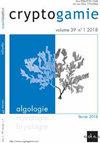Genetic Affinities and Biogeography of Putative Levantine-Endemic Seaweed Treptacantha rayssiae (Ramon) M.Mulas, J.Neiva & Á.Israel, comb. nov. (Phaeophyceae)
IF 1.5
4区 生物学
Q3 MARINE & FRESHWATER BIOLOGY
引用次数: 5
Abstract
ABSTRACT Cystoseira sensu lato (Ochrophyta) forests are important habitat formers in the Mediterranean Sea, but they have mostly been studied in the western basin where many species are under decline. In the eastern basin, where fewer species occur, Cystoseira rayssiae Ramon was described in the year 2000 as an endemic species based on morphological characteristics from herbaria samples collected on the Israeli coast. No further investigations have been conducted on this peculiar species since, but recently it has been recorded in contiguous Lebanon and outside the Mediterranean. Our work was aimed at confirming the taxonomic validity and endemic nature of this species, including its position among the recently split Cystoseira sensu stricto, Carpodesmia Greville and Treptacantha Kützing genera, by sequencing the mitochondrial COI gene and by examining morphological characteristics in samples from three different sites in northern Israel. Notwithstanding considerable morphological plasticity, molecular analyses revealed a single unique COI sequence. Phylogenetic analyses show that Cystoseira rayssiae belongs to the resurrected genus Treptacantha and hence, the new combination Treptacantha rayssiae (Ramon) M.Mulas, J.Neiva & Á.Israel, comb. nov., is proposed. Unique sequences and a restricted range support its Levantine-endemic status. Intriguing extra-Mediterranean reports from the Red Sea and the Persian Gulf are probably misidentifications rather than reflecting a disjunct distribution or recent invasion.地中海特有海藻Treptacantha rayssiae (Ramon) M.Mulas, J.Neiva & Á。以色列,梳子。11月(褐藻纲)
摘要/ ABSTRACT摘要:褐藻(Cystoseira sensu lato, Ochrophyta)森林是地中海重要的生境形成者,但对它们的研究大多集中在西部盆地,那里许多物种正在减少。在物种较少的东部盆地,根据在以色列海岸收集的植物标本的形态特征,2000年将rayssiae Cystoseira Ramon描述为一种特有物种。此后没有对这一特殊物种进行进一步的调查,但最近在邻近的黎巴嫩和地中海以外的地区有了记录。我们的工作旨在通过对来自以色列北部三个不同地点的样品进行线粒体COI基因测序和形态特征检测,确认该物种的分类有效性和特有性质,包括其在最近分裂的Cystoseira sensu stricto, Carpodesmia Greville和Treptacantha k tzing属中的位置。尽管有相当大的形态可塑性,分子分析显示单一独特的COI序列。系统发育分析表明,Cystoseira rayssiae属于复活的Treptacantha属,因此,新组合Treptacantha rayssiae (Ramon) M.Mulas, J.Neiva & Á。以色列,梳子。建议11月11日。独特的序列和有限的范围支持其黎凡特地方性的地位。来自红海和波斯湾的有趣的地中海外报告可能是错误的识别,而不是反映了不连贯的分布或最近的入侵。
本文章由计算机程序翻译,如有差异,请以英文原文为准。
求助全文
约1分钟内获得全文
求助全文
来源期刊

Cryptogamie Algologie
生物-海洋与淡水生物学
CiteScore
2.60
自引率
7.70%
发文量
11
审稿时长
>12 weeks
期刊介绍:
Cryptogamie is a fast-track and peer-reviewed journal of international scope publishing in English only. It accepts original papers and review articles on the taxonomy, biology and ecology of all cryptogams. An issue of Cryptogamie may be devoted to a single topic, under the responsibility of guest editor(s). All articles published in Cryptogamie are compliant with the different nomenclatural codes. A copyright assignment will be signed by the authors before publication.
Cryptogamie, Algologie accepts articles on systematics as well as ecology and evolution of any kind of algae (including Cyanobacteria).
 求助内容:
求助内容: 应助结果提醒方式:
应助结果提醒方式:


